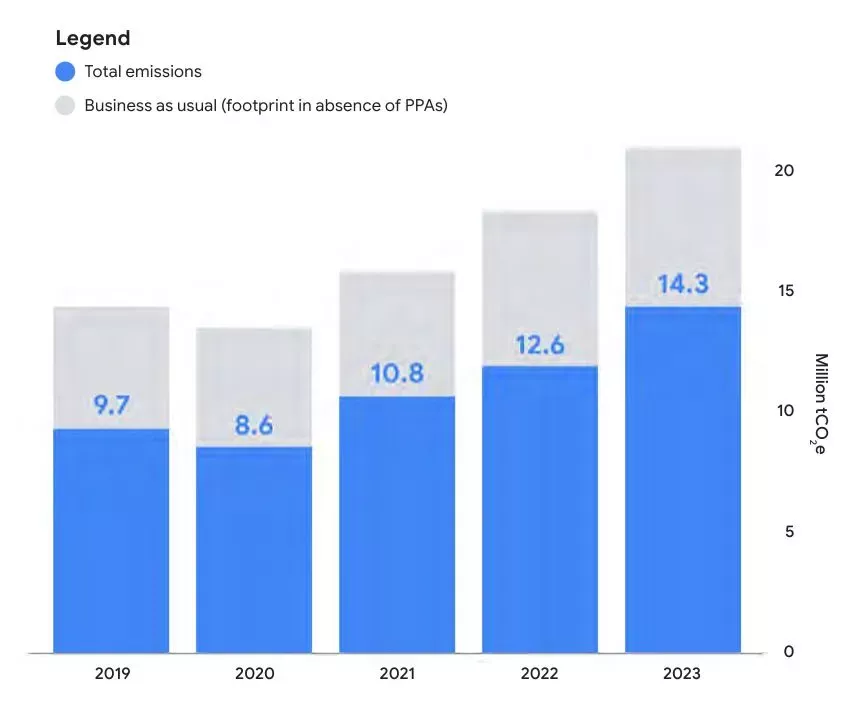Table of Contents
Introduction
Google’s Environmental Report for 2024, a comprehensive document spanning over 80 pages, details the tech giant’s efforts to tackle environmental issues and reduce its own ecological footprint. While the report extensively covers initiatives like water replenishment and renewable energy, it conspicuously avoids addressing the significant energy consumption associated with its growing artificial intelligence (AI) operations. This gap in reporting raises concerns about the true environmental impact of Google’s Environmental AI endeavors.
Google’s Environmental Initiatives
Google’s Environmental Report highlights several laudable initiatives aimed at mitigating the company’s environmental impact. These include efforts to achieve carbon neutrality, increase the efficiency of data centers, and invest in renewable energy. One notable project is Google’s water replenishment program, designed to offset water used in its facilities through watershed restoration and irrigation management. Currently, Google has managed to replenish 18% of its water usage through such projects, demonstrating a commitment to improving water sustainability year by year.
AI’s Potential Environmental Benefits
The report also emphasizes the potential benefits of AI in addressing climate challenges. Google showcases applications of AI in optimizing water systems, creating fuel-efficient transportation routes, and predicting natural disasters like floods. These advancements are significant, as they offer practical solutions to environmental problems. Google’s proactive stance in using AI for environmental good is commendable and sets a positive example for other large corporations.
The Elephant in the Room: AI’s Energy Consumption
However, despite the positive highlights, Google’s Environmental Report falls short in addressing a critical issue: the substantial energy consumption of AI. As AI becomes more integrated into Google’s operations, understanding its energy footprint is essential for a complete picture of the company’s environmental impact.
The Hidden Costs of AI Training
Training AI models requires immense computational resources. A study by the University of Massachusetts Amherst found that training a single AI model could emit as much carbon as five cars over their lifetimes. This is because training involves processing large datasets and running numerous iterations to refine the model. The energy required for this process often comes from sources that are not entirely renewable, contributing significantly to greenhouse gas emissions.
Operational Energy Demands of AI
Beyond training, the operational phase of AI models also demands substantial energy. AI applications, such as real-time language translation and personalized recommendations, require continuous computational power to function effectively. This ongoing energy consumption adds to the overall environmental cost of AI, which is not adequately addressed in Google’s report.
In the section titled “Responsibly managing the resource consumption of AI,” Google’s Environmental Report offers a vague discussion on AI’s energy use. The report states that predicting the future environmental impact of AI is complex and evolving, and therefore, it focuses on data center-wide metrics rather than specific AI-related energy consumption. This lack of specificity suggests an avoidance of revealing the actual energy costs associated with AI.
Generalizing Data Center Metrics
Google claims that AI’s energy consumption is intertwined with general data center operations, making it difficult to isolate and report separately. The report mentions that data centers account for only 1.3% of global energy usage, and Google’s share is approximately 10% of that. This suggests that AI’s energy use is a minor fraction of the overall data center energy consumption. However, this broad generalization obscures the significant energy demands of AI-specific tasks, which can be much higher than those of traditional data processing.

Efficiency Initiatives and Their Limits
While Google highlights efficiency improvements in its data centers and the development of custom AI server units, these advancements do not fully offset the growing energy demands of AI. The company has invested in reducing the energy required to train AI models and improving the efficiency of AI hardware. However, without transparent reporting, it remains unclear how these efforts impact the overall energy footprint of AI.
The Need for Transparency in Reporting
For Google to truly lead in environmental stewardship, it must provide a clear and comprehensive account of the energy consumption associated with AI. Transparent reporting on AI’s energy use would enable stakeholders to understand the full extent of Google’s environmental impact and hold the company accountable for its AI-related activities.
Google’s Environmental Report should include specific metrics on the energy use of AI training and operations. This would involve separating AI-related energy consumption from general data center usage and reporting it transparently. Such metrics would provide a more accurate picture of how AI contributes to Google’s overall energy footprint.
In addition to transparent reporting, Google should prioritize sustainable AI practices. This includes investing in research to develop more energy-efficient AI algorithms and hardware. By reducing the computational power required for AI tasks, Google can mitigate the environmental impact of its AI operations and set a standard for sustainable AI development in the tech industry.
Conclusion
Google’s Environmental Report for 2024 offers valuable insights into the company’s efforts to address environmental issues. However, the omission of detailed information on AI’s energy consumption represents a significant gap in the report. As AI continues to expand within Google’s operations, understanding its environmental impact is crucial. Transparent reporting and a commitment to sustainable AI practices will reinforce Google’s role as a leader in both technology and environmental responsibility.
By addressing the energy costs of AI, Google can ensure that its advancements in artificial intelligence do not come at the expense of the planet. As the company prepares for future environmental reports, it has the opportunity to set a new benchmark in transparency and accountability, paving the way for a more sustainable approach to AI and technology as a whole.